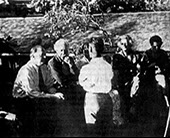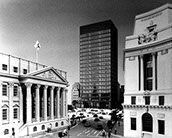Master's Thesis
FAUP, Porto, 2011
Advising Professor
Carlos Machado, Arch.
Examining Professor
Nuno Brandão Costa, Arch.
The knowledge of the conditions and premises related to the development of the Modern Movement is essential for a better understanding of the architecture of the 20th century and, accordingly, of contemporary architecture. Thus, a thorough study, such as the one presented here, of an exceptional modern author like Mies van der Rohe, has naturally some relevance.
However, general approaches to a character of this magnitude tend to be reductive in the face of the architectural richness, variety and quality present in all his work.
Hence, we chose to direct this investigation towards the

questioning of less explored or more ambiguous and even potentially contradictory issues that stand out from his work.
Therefore, we defined five main themes upon which we structured our take on the architecture of Mies van der Rohe:
1. Tradition and Avant-garde, that focuses on the first years of Mies’ professional activity and on the inconsistencies associated with maintaining a practice at the same time traditional and avant-garde.
2. Symmetry, that looks at the very particular use of this compositional principle in his work.

3. Organic Architecture, that tries to understand the role played by Nature as a model on the definition of Mies’ architectural thought and practice.
4. Truth and Representation, that seeks to assess the importance of Mies in the definition of an intelligible figuration of the modern city and architecture and to comprehend how this dimension adjusts to the premises of constructive truth he endorsed.
5. Architecture and Context, that tries to evince the kind of attitude adopted by Mies facing the local conditions of the contexts where his architecture was settled.
|

From the work that was carried out based on the careful study of Mies’ architectural production and with the support of some renowned authors’ critical production, several interesting notions arise which give evidence of the extent, heterodoxy and even contrast of the premises of his architecture and, consequently, of the architecture of the Modern Movement. In a certain way these notions reflect the relevance nowadays of a renewed interest to deepen the understanding of the work of this and other essential authors of modernism.